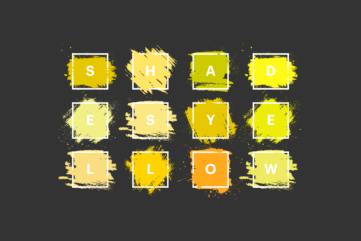What colors make purple? Your guide on how to make purple

What colors make purple, and how can you ensure your shade of purple is perfect for your needs? You might already know mixing blue and red creates a basic purple color. However, there are many different tints, hues, and styles of purple to choose from for other occasions.
Purple can be cool and mysterious or warm and luxurious. The color is primarily associated with concepts like indulgence and royalty. This can make it an excellent choice for a brand color palette when a company wants to convey a sense of sophistication.
However, certain shades of purple can evoke different emotions.
As an example, darker purple colors are often connected to mystery and enigma, while lighter alternatives are seen as loving and compassionate. If you’re working on building the ultimate palette for your next artistic project, here’s everything you need to know about how to make purple.
How to make the color purple: an Introduction
So, what colors make purple? Most of us learn how to make purple relatively early when we start mixing the primary colors in our paint kits. Blue and red combined will create a purple shade, but the type of paints or hues you use will make a massive difference to the purple you produce.
Adding red will generally create a warmer, redder purple, while extra blue will create a bluer shade. Additionally, it’s possible to enhance or alter the appearance of your purple by adding other colors, like gray, yellow, or white.
The versatility of purple makes it an excellent choice for a range of use cases. In color psychology, it’s a hue associated with luxury, indulgence, compassion, and mystery. In art, purple can be a fantastic way to bring depth or shadow to your project.
Understanding the science involved in creating the ideal purple swatches will ensure you can design the perfect purple color combos for your needs.
Is purple a real color? The science
One point to note before we get into the basics of making purple is that this shade is a unique type of color. Violet, which is often confused with purple, is a spectral shade. This means it consists of one wavelength of light. Alternatively, purple is a “color mixture.”
This means it combines various light waves to create a unique effect (generally blue and red).
In a physical sense, this means purple is unlike any other color you might be familiar with – but this doesn’t make it any less of an actual shade.
Objects have specific physical properties that allow them to absorb certain wavelengths of light. The waves which aren’t absorbed are then reflected, which creates the color we see. With violet, only one wave is left for the eyes to absorb.
With purple, various wavelengths work together simultaneously to create a specific hue.
Purple’s physical properties are part of why it’s important to get your mixing palette just right. The different shades you combine to make purple will influence which wavelengths are reflected back at the people viewing your piece.
Mixing Purple: What makes purple?
Learning how to make purple means embracing different forms of color-mixing processes. Simply knowing what colors make purple isn’t enough. The most successful artists and creators know how to leverage the right kind of mixing to create different effects.
The most common options include the following:
Additive mixing
Additive mixing in the artistic world is used for mixing the specific light waves intended to make purple. It involves layering different wavelengths over each other and often combining them with a white object.
Typically, in additive mixing, the colors of blue and red light are combined in different proportions to generate a specific result. Depending on the shades you add, the hue you get will vary.
Subtractive mixing
In subtractive mixing, artists work on removing the wavelengths visible to the human eye by using various pigments, dyes, and paints.
Subtractive mixing removes specific wavelengths entirely. For example, mixing blue and red colors combines different wavelengths of dye which can stop other colors from being reflected into our vision.
Tints and shades
Artists and designers also create purple by making specific tints and shades.
To create a tint, professionals add white and similar shades to another color to adjust its saturation. A color with a lot of black or white added to it has low saturation, while one with minimal added colors has high saturation. This is why bright purple requires very little additional white or black.
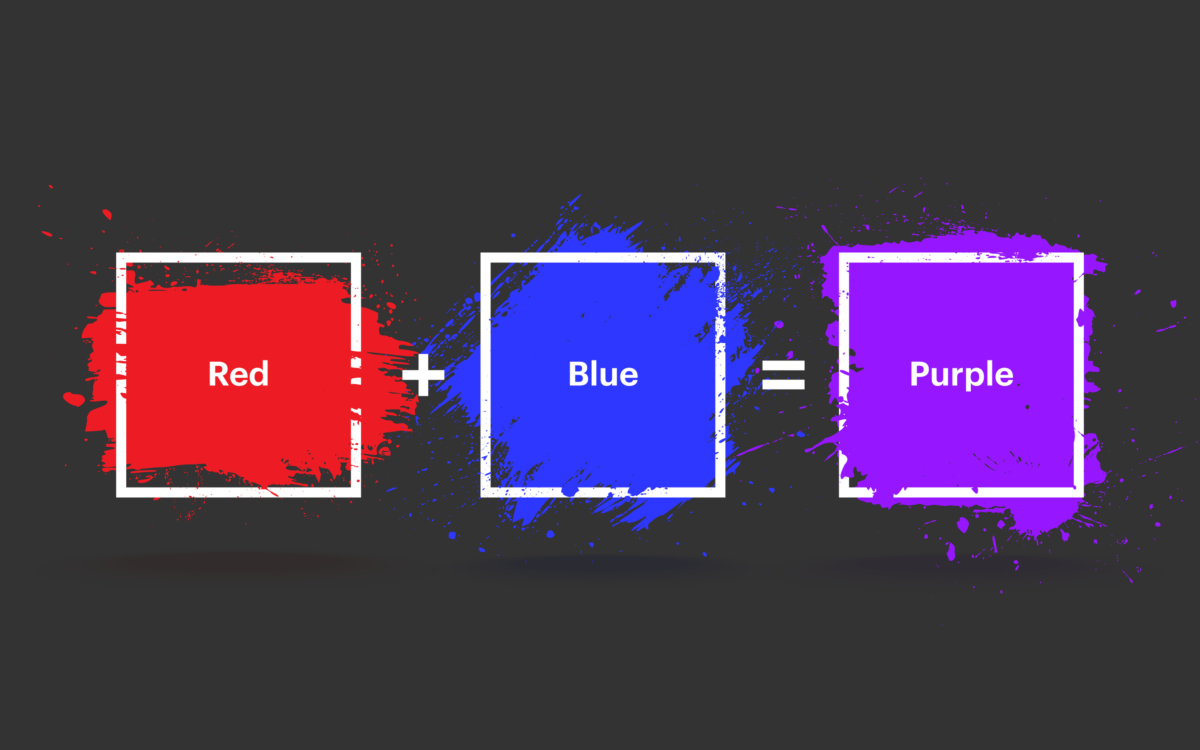
What two colors make purple?
Now we’ve covered the basics, let’s dive into an objective discussion of what colors make purple. First and foremost, the most common colors used to make purple are red and blue. As you may already know, purple is a secondary color created by combining two primary colors.
Red and blue combined make purple automatically. However, the types or shades of blue and red you use will influence the resulting purple. An Ultramarine Blue shade will generally make a dark purple, while a Cobalt Blue will create a lighter or brighter shade.
Purple mixed with a deep red like Alizarin Crimson will usually be cooler in color temperature.
Mixing blue and red
The properties created in the shade of purple you design will be influenced by the properties of the initial “primary” color. The cooler the two initial colors are, the cooler the resulting purple will be. The brighter the initial shades, the more you’ll edge toward a bright purple.
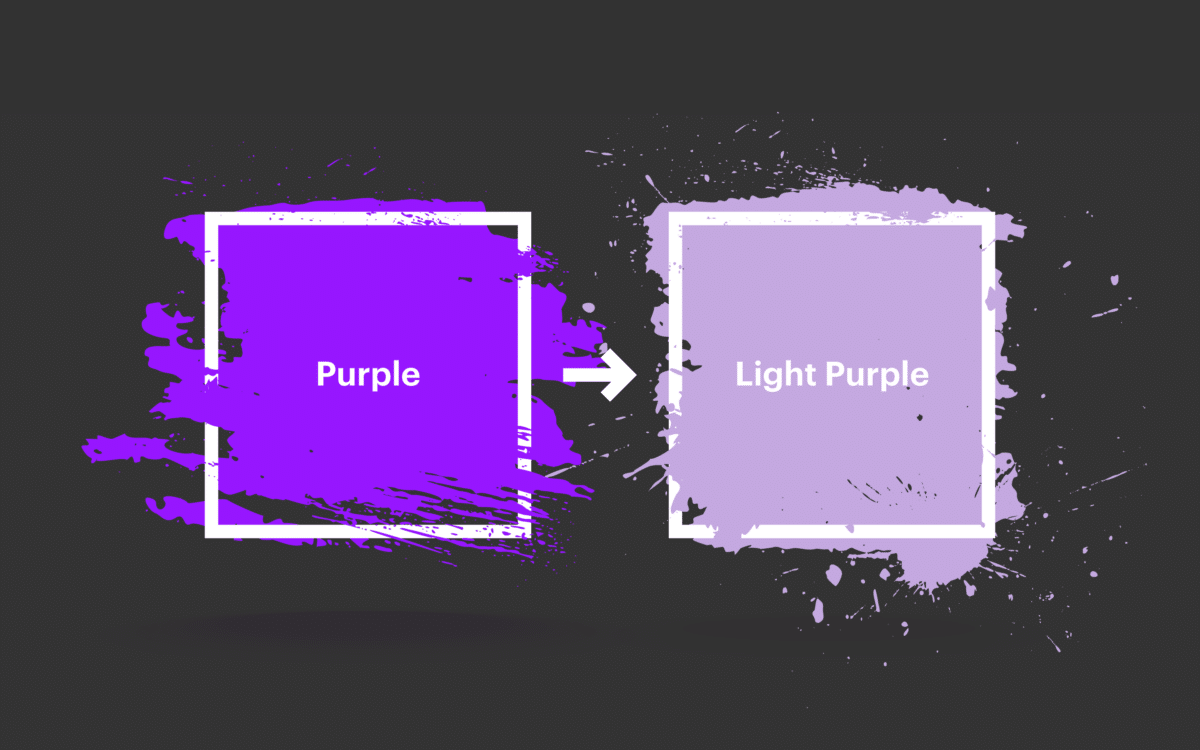
What colors make light purple?
While the simple answer to “what colors make purple” is simply red and blue, the purple color spectrum is much larger than most people realize. In most cases, merely creating purple swatches with basic blue and red colors will make quite a dark purple.
This is because blue and red are already very saturated and rich shades.
If you want to make a light purple, you’ll need to add extra “tints” into the shade to help reduce the saturation and pull attention to the underlying shade. White is the most obvious color to add to purple color combos to create light purple.
However, lightening your purple and giving it other qualities with different colors is possible. To make a color lighter, you must mix in color with a lighter color value. Yellow is an excellent choice. Yellow can be an excellent tool for muting purple, as seen in the sections below. However, a light yellow can also create warm purple colors.
To get the best results when lightening purple with yellow, it’s crucial to choose quite a simple shade of yellow without much saturation. Cadmium Lemon Yellow is popular among artists as it has a much lower color value than some other shades.

What colors make dark purple?
Once you know how to make light purple colors, you may also want to explore creating dark purple colors. Purple is naturally pre-disposed to be quite a dark color. Mixing your standard blue and red shades will automatically create quite a dark hue.
However, you can intensify this result and create a deep purple color with different mixing strategies.
The best way to create a dark purple is to start with your basic shade of purple, then add in other colors with a darker value. For example, if you’re starting with a violet shade of purple, adding colors like Burnt Umber can create quite a cool, earthy purple.
Alternatively, adding Phthalo Green and Alizarin Crimson creates a rich and slightly warmer shade.
Once again, it’s worth considering color temperatures when producing a deep purple color. Cooler purple color combos like Dioxazine Purple and Burnt Umber will usually result in an almost grey shade.
While warmer colors like Provence Violet Blush and Alizarin Crimson create a brighter, warmer hue of purple.
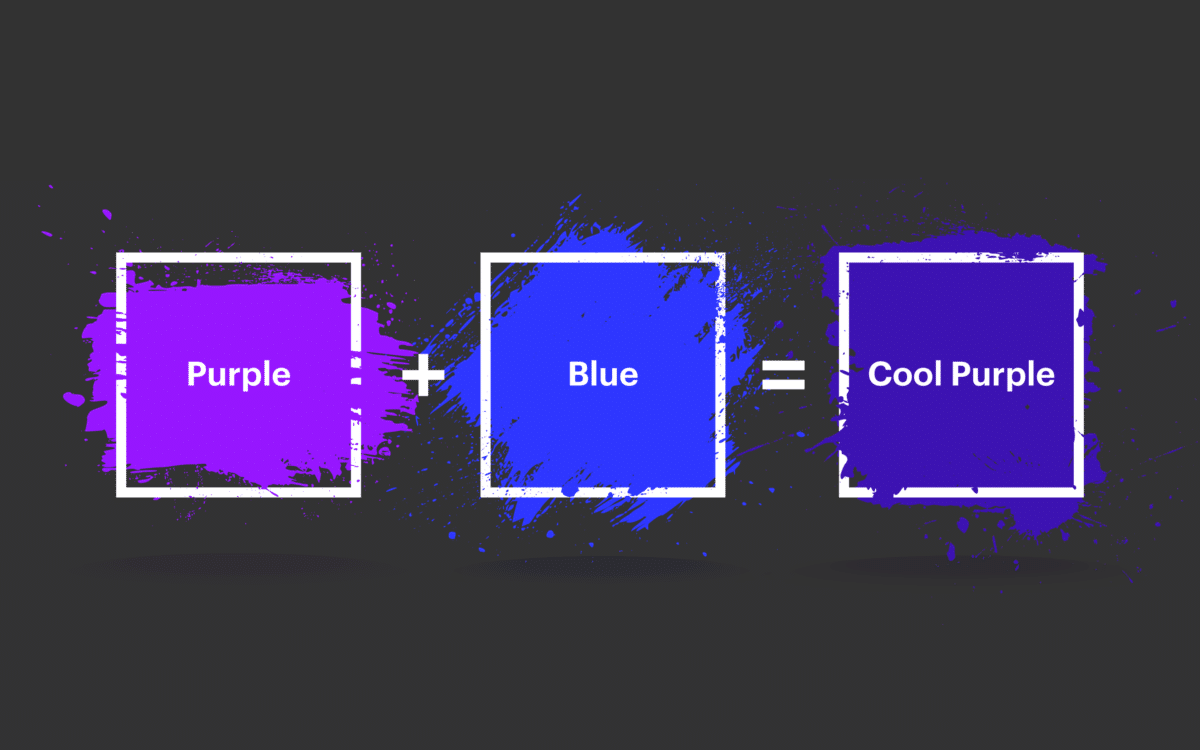
Cool purples: How to make a purple-blue color
Colors fall into not just different depths but temperatures too. When mixing your palette, you may want some hues to appear warmer while others are cooler. So, what colors make purple seem cooler? The simple answer is to start with colors with a relatively cool profile.
When learning how to make purple cool, it’s a good idea to focus on more “blue” shades. This is because blue is a naturally cool color, to begin with. Adding blue to an existing purple hue will cool it down even more, removing any red or warmer elements.
Your shade of blue will determine how deep or rich your purple is. As an example, mixing Ultramarine Blue and Dioxazine Purple creates an almost entirely blue shade. Alternatively, if you mix a light shade of purple with the same color, you get a brighter finish.
Sometimes, it’s possible to make purple seem cooler by adding other shades, such as grey. However, this will also lighten the purple and remove some saturation, which means you will have a more muted shade.
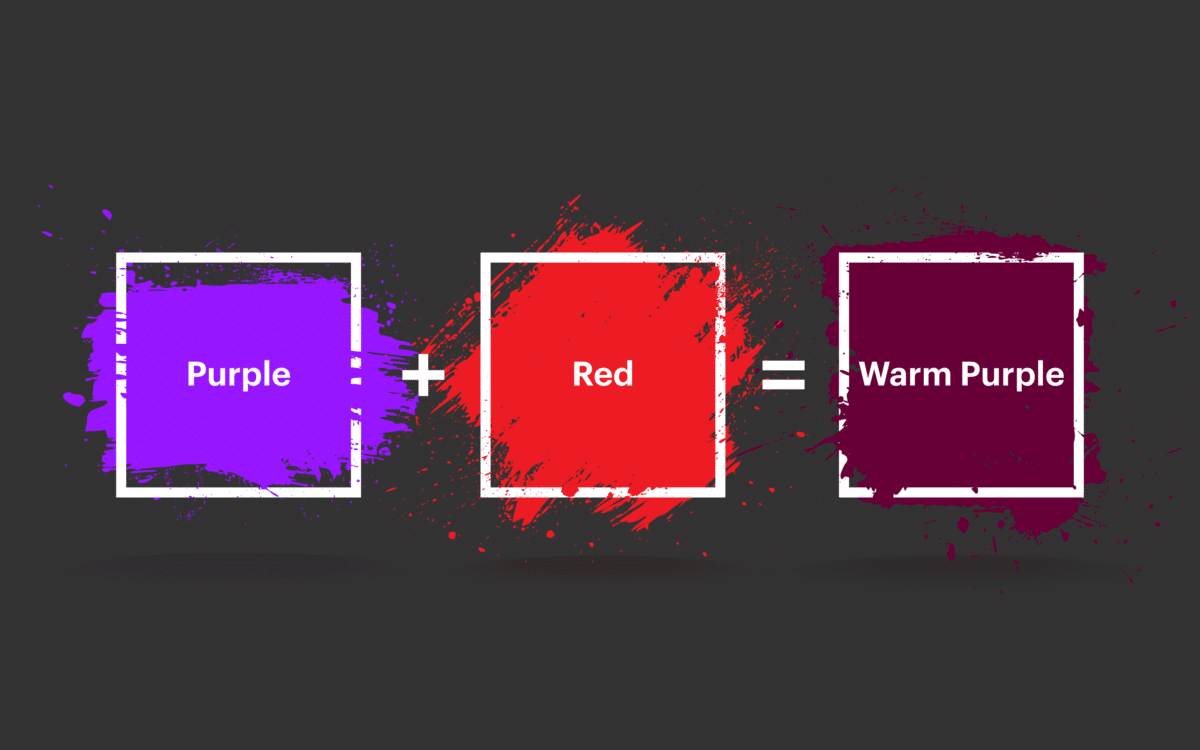
How to make warm purple colors
How to make warm purple colors
Warm purple colors are often associated with compassion and luxury, making them popular for many use cases. Mixing warm purples is just as important as creating the ultimate cool purple.
As you might have guessed, while adding more blue to a purple hue will enhance its coolness, adding more red has the opposite effect.
Red is a naturally warm color, which helps to enhance the overall warmth of the resulting shade you create. Adding Alizarin Crimson to a Violet Purple will give you a rich and deep shade of warm purple. Combining the same purple with Cadmium Red takes the warmth to the next level.
When mixing warm purple shades, remember that the deeper the colors you start with, the darker the eventual shade will become. Dioxazine Purple already absorbs many of the light wavelengths required to make colors, leading to a remarkably dark finish when combined with any red.

How to make light purple muted colors
While bright purple and highly saturated colors can be fantastic in the right circumstances, they’re not ideal for every use case.
Sometimes, you may find yourself wanting to design more muted colors. This can help make brighter shades stand out in your project or bring shadow to an element. Fortunately, there are various ways to mute your purple.
The easiest way to mute any color is to mix a shade with the “complementary color” on the color wheel.
The complementary color for any shade on the color wheel is the one that appears directly opposite to the hue. This means red is the complementary color for green, and yellow is the complementary color for purple.
The complementary shade on the color wheel contrasts the existing color to create something new. Mixing purple with yellow will subtract some of its depth and brightness to create more earthy and even grey tones.
Mixing Yellow Ochre, which is quite a dark shade of yellow, with purple will create quite a deep grey tone, ideal for waterscape paintings. However, if you mix Cadmium Yellow, a brighter shade, with your existing purple, you get a slightly more radiant finish.
Artists often experiment with different yellows and purples combined to create the ultimate effect. It’s worth working on some color swatches of your own to see what results you can achieve.
How to make a deep purple color: Other purple mixing tips
So far, we’ve covered some of the most valuable tools you can use to mix your ideal shade of purple. However, there are still other options available. For example, you can use purple to design earthy, bright, or deep colors.
Creating earth tones of purple
Purple is an excellent hue for mixing earth colors. Mixing additional hues into your existing purple creation can be a fantastic way to mute the shades and help other colors stand out. Mixing red, blue, and different shades, such as Burnt Sienna, is one of the best ways to design an earthy finish.
How to make deep purple colors
If you want to know how to make purple as deep as possible, the best option is to start with blue and red and add the slightest amount of black. This helps to block out any additional wavelengths and make the purple as dark and mysterious as possible.
What colors mixed together make purple? FAQ
Still have questions about what colors make purple? The following FAQs could help:
Q: How do you make a vivid purple?
As mentioned above, brighter purples are often achieved using equal amounts of pure red and pure blue. This allows you to design the most saturated purple possible. You can then adjust the saturation according to your needs with black and white.
Q: What is the complementary color of purple?
Every shade on the color wheel has its own complementary color. This is the color opposite to the intended shade on the wheel. For purple, the complementary color is yellow. Mixing these two shades creates a muted hue.
Q: Which is the best blue for mixing purple?
There’s no one-size-fits-all answer to this question. The blue you choose will need a color bias toward your intended purpose. A warmer blue creates a more vibrant purple color, while a cooler blue is excellent for colder shades.
Q: Is violet the same as purple?
Violet is slightly different from purple as it’s a spectral color. This means it only needs one specific light wavelength. Alternatively, purple is a combination of colors (red and blue). This implies that both violet and purple have unique places in the color spectrum.
Q: Why can’t I make purple?
Generally, anyone can make purple by mixing red and blue in various amounts. However, the kinds of colors you create will vary depending on the hues you start with. Experimenting with different types of blues and reds will help you to find the ideal shade.
Q: What other colors can you make with purple?
Purple is quite an intense base color to have on your mixing palette. When you mix another color with this shade, you end up with a different type of purple. This is because purple is a secondary color, so it’s not ideal for mixing new shades.
Mixing purple shades for your art pieces
Hopefully, this guide has given you a clear answer to the question, “What colors make purple?” While the simplest way to learn how to make purple is to mix different shades of red and blue, there are various ways you can adjust the results of your purple with mixing strategies.
Adding white, black, yellow, and other shades to your purple will determine whether you end up with a bright, deep, earthy, or muted shade. One of the best ways to ensure you’re always using the right color for your needs is to create swatches of each paint style you make.
Fabrik: A branding agency for our times.
Now read these:
—What does purple mean in marketing?
—Should you use purple in packaging design?
—Is purple a good color for logo design?
—Understanding the psychology of purple
—What does purple signify in branding?
—Why is purple associated with royalty?
—A guide to colors that complement purple
—Your guide to which colors make purple
—Definitive guide to the shades of purple
—Popular companies with purple logos
—Exploring the colors of the rainbow





